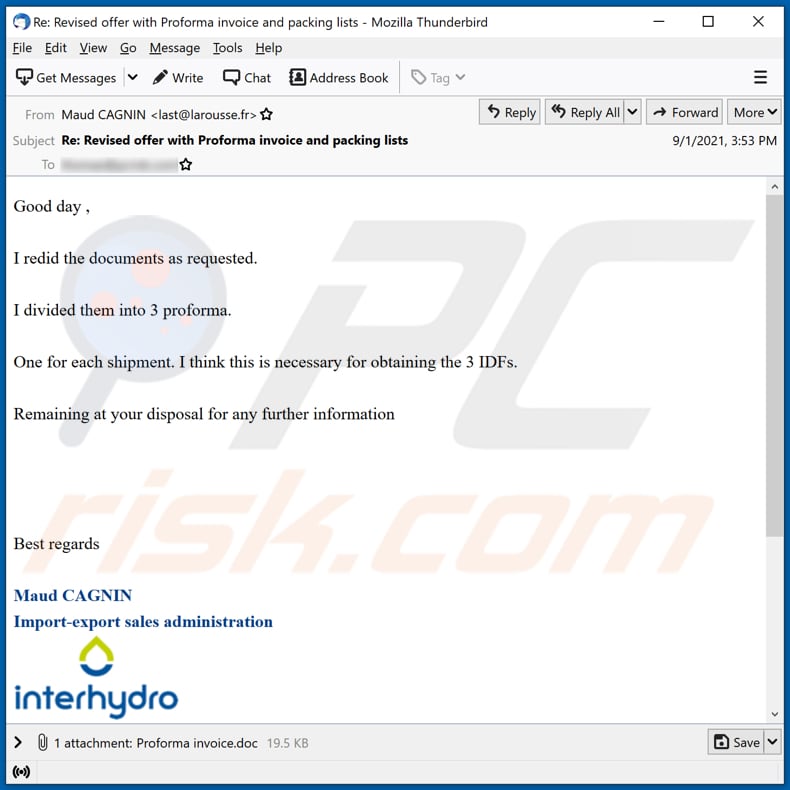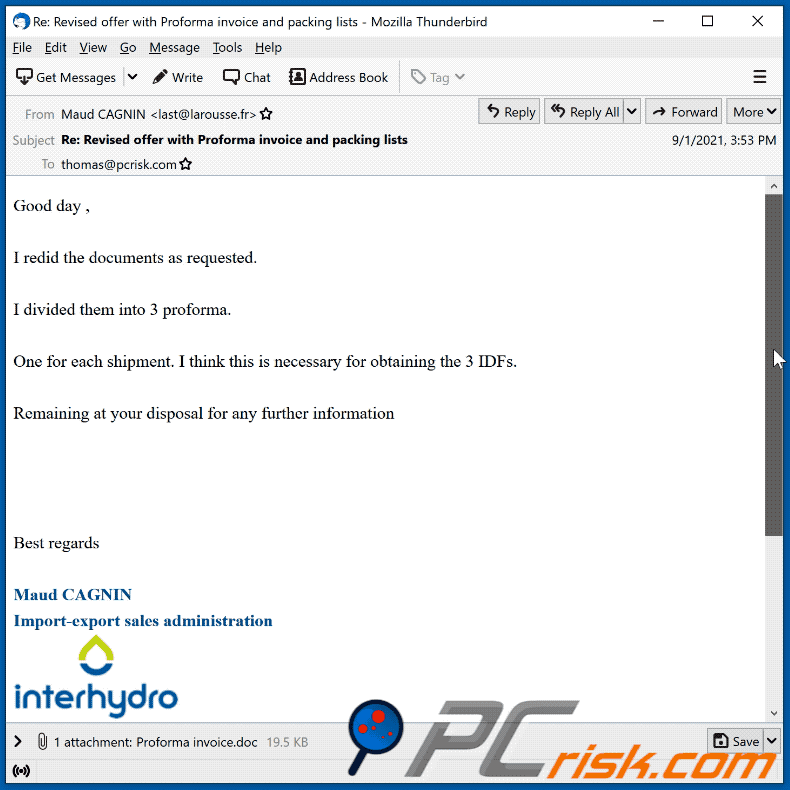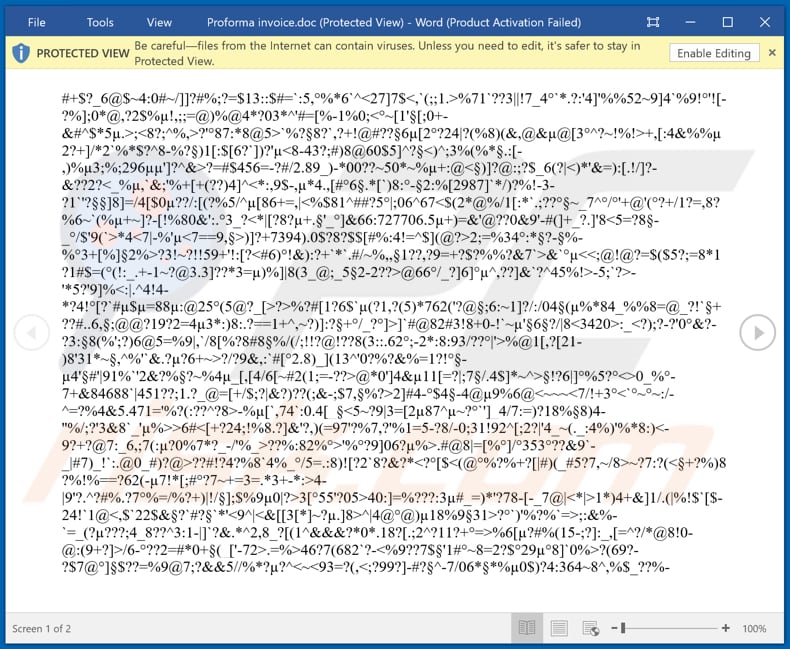How to avoid installation of FormBook via fake Interhydro email?
Phishing/ScamAlso Known As: Interhydro spam
Get free scan and check if your device is infected.
Remove it nowTo use full-featured product, you have to purchase a license for Combo Cleaner. Seven days free trial available. Combo Cleaner is owned and operated by RCS LT, the parent company of PCRisk.com.
What is Interhydro email virus?
When cybercriminals use emails to deliver malware, they send malicious attachments or website links. Their main goal is to trick recipients into opening a file designed to install malicious software. Cybercriminals behind this email are pretending to be Interhydro (a legitimate French company). They use this email to deliver FormBook malware.

Interhydro email virus in detail
Cybercriminals behind this email attempt to trick recipients into believing that the file attached to it ("Proforma invoice.doc") is a proforma invoice and a packing list. Once opened, that document asks for permission to enable editing (macros commands). It installs FormBook after enabling macros commands in it.
FormBook can collect clipboard data, visited websites, take screenshots, extract saved login credentials (usernames. passwords, etc.), record keystrokes/keyboard input. Also, it can execute commands, download and execute files and perform other tasks that could cause the installation of other malware (for example, ransomware).
| Name | Interhydro spam |
| Threat Type | Trojan, password-stealing virus, banking malware, spyware. |
| Hoax | Email has a proforma invoice from Interhydro company attached to it |
| Attachment(s) | Proforma invoice.doc (its name may vary) |
| Detection Names | Avast (RTF:Obfuscated-gen [Trj]), Combo Cleaner (Trojan.Exploit.MSOfficeWord.GenericKD.46912504), ESET-NOD32 (A Variant Of Generik.BRKWYQX), Kaspersky (UDS:DangerousObject.Multi.Generic), Microsoft (Exploit:O97M/CVE-2017-11882.BKQT!MTB), Full List Of Detections (VirusTotal) |
| Symptoms | Trojans are designed to stealthily infiltrate the victim's computer and remain silent, and thus no particular symptoms are clearly visible on an infected machine. |
| Payload | FormBook |
| Distribution methods | Infected email attachments, malicious online advertisements, social engineering, software 'cracks'. |
| Damage | Stolen passwords and banking information, identity theft, the victim's computer added to a botnet. |
| Malware Removal (Windows) |
To eliminate possible malware infections, scan your computer with legitimate antivirus software. Our security researchers recommend using Combo Cleaner. Download Combo CleanerTo use full-featured product, you have to purchase a license for Combo Cleaner. 7 days free trial available. Combo Cleaner is owned and operated by RCS LT, the parent company of PCRisk.com. |
Malicious emails in general
Most cybercriminals disguise malicious emails as important, official documents from legitimate companies (in this case, Interhydro). Recipients install malware after opening malicious attachments (or files downloaded via provided links). More examples of malspam campaigns are "Taxve Inc.", "UAT Feedback", and "Assurance Certificates".
How did "Interhydro email virus" infect my computer?
This email has the "Proforma invoice.doc" file (its name may vary) attached to it. That attachment installs malware after opening it and enabling macros commands (editing/content). Other malicious emails can be used to deliver malware via Microsoft Excel or PDF documents, executable files, JavaScript files, archive files, etc.
Microsoft Office 2010 and newer versions have the Protected View mode - they do not allow malicious documents to infect computers without enabling macros commands. Older MS Office versions do not have the aforementioned mode. Thus, malicious documents opened with them infect computers automatically.
How to avoid installation of malware?
Attachments or links in irrelevant emails sent from unknown or suspicious addresses should not be opened - they could be malicious. Downloads from unreliable sources like unofficial pages, third-party downloaders, Peer-to-Peer networks should not be opened as well. Files and programs should be downloaded only from legitimate pages.
Installed programs have to be updated or activated with tools provided by their developers - most third-party tools are malicious. The operating system should have a reputable antivirus or anti-spyware software installed on it. The system should be scanned for malware on a regular basis.
If you've already opened "Interhydro email virus" attachment, we recommend running a scan with Combo Cleaner Antivirus for Windows to automatically eliminate infiltrated malware.
Appearance of the fake Interhydro email (GIF):

Text presented in the fake Interhydro email:
Re: Revised offer with Proforma invoice and packing lists
Good day ,
I redid the documents as requested.
I divided them into 3 proforma.
One for each shipment. I think this is necessary for obtaining the 3 IDFs.
Remaining at your disposal for any further information
Best regards
Maud CAGNIN
Import-export sales administration
interhydro
17 Professor Jean Bernard Street
Korner - BAT C - 2nd floor
69007 LYON, France
TEL: +33 (0) 4 78 33 09 09
FAX: +33 (0) 4 78 33 07 28
web: www.interhydro.fr
Screenshot of the malicious attachment ("Proforma invoice.doc"):

Instant automatic malware removal:
Manual threat removal might be a lengthy and complicated process that requires advanced IT skills. Combo Cleaner is a professional automatic malware removal tool that is recommended to get rid of malware. Download it by clicking the button below:
DOWNLOAD Combo CleanerBy downloading any software listed on this website you agree to our Privacy Policy and Terms of Use. To use full-featured product, you have to purchase a license for Combo Cleaner. 7 days free trial available. Combo Cleaner is owned and operated by RCS LT, the parent company of PCRisk.com.
Quick menu:
- What is Interhydro spam?
- Types of malicious emails.
- How to spot a malicious email?
- What to do if you fell for an email scam?
Types of malicious emails:
![]() Phishing Emails
Phishing Emails
Most commonly, cybercriminals use deceptive emails to trick Internet users into giving away their sensitive private information, for example, login information for various online services, email accounts, or online banking information.
Such attacks are called phishing. In a phishing attack, cybercriminals usually send an email message with some popular service logo (for example, Microsoft, DHL, Amazon, Netflix), create urgency (wrong shipping address, expired password, etc.), and place a link which they hope their potential victims will click on.
After clicking the link presented in such email message, victims are redirected to a fake website that looks identical or extremely similar to the original one. Victims are then asked to enter their password, credit card details, or some other information that gets stolen by cybercriminals.
![]() Emails with Malicious Attachments
Emails with Malicious Attachments
Another popular attack vector is email spam with malicious attachments that infect users' computers with malware. Malicious attachments usually carry trojans that are capable of stealing passwords, banking information, and other sensitive information.
In such attacks, cybercriminals' main goal is to trick their potential victims into opening an infected email attachment. To achieve this goal, email messages usually talk about recently received invoices, faxes, or voice messages.
If a potential victim falls for the lure and opens the attachment, their computers get infected, and cybercriminals can collect a lot of sensitive information.
While it's a more complicated method to steal personal information (spam filters and antivirus programs usually detect such attempts), if successful, cybercriminals can get a much wider array of data and can collect information for a long period of time.
![]() Sextortion Emails
Sextortion Emails
This is a type of phishing. In this case, users receive an email claiming that a cybercriminal could access the webcam of the potential victim and has a video recording of one's masturbation.
To get rid of the video, victims are asked to pay a ransom (usually using Bitcoin or another cryptocurrency). Nevertheless, all of these claims are false - users who receive such emails should ignore and delete them.
How to spot a malicious email?
While cyber criminals try to make their lure emails look trustworthy, here are some things that you should look for when trying to spot a phishing email:
- Check the sender's ("from") email address: Hover your mouse over the "from" address and check if it's legitimate. For example, if you received an email from Microsoft, be sure to check if the email address is @microsoft.com and not something suspicious like @m1crosoft.com, @microsfot.com, @account-security-noreply.com, etc.
- Check for generic greetings: If the greeting in the email is "Dear user", "Dear @youremail.com", "Dear valued customer", this should raise suspiciousness. Most commonly, companies call you by your name. Lack of this information could signal a phishing attempt.
- Check the links in the email: Hover your mouse over the link presented in the email, if the link that appears seems suspicious, don't click it. For example, if you received an email from Microsoft and the link in the email shows that it will go to firebasestorage.googleapis.com/v0... you shouldn't trust it. It's best not to click any links in the emails but to visit the company website that sent you the email in the first place.
- Don't blindly trust email attachments: Most commonly, legitimate companies will ask you to log in to their website and to view any documents there; if you received an email with an attachment, it's a good idea to scan it with an antivirus application. Infected email attachments are a common attack vector used by cybercriminals.
To minimise the risk of opening phishing and malicious emails we recommend using Combo Cleaner Antivirus for Windows.
Example of a spam email:

What to do if you fell for an email scam?
- If you clicked on a link in a phishing email and entered your password - be sure to change your password as soon as possible. Usually, cybercriminals collect stolen credentials and then sell them to other groups that use them for malicious purposes. If you change your password in a timely manner, there's a chance that criminals won't have enough time to do any damage.
- If you entered your credit card information - contact your bank as soon as possible and explain the situation. There's a good chance that you will need to cancel your compromised credit card and get a new one.
- If you see any signs of identity theft - you should immediately contact the Federal Trade Commission. This institution will collect information about your situation and create a personal recovery plan.
- If you opened a malicious attachment - your computer is probably infected, you should scan it with a reputable antivirus application. For this purpose, we recommend using Combo Cleaner Antivirus for Windows.
- Help other Internet users - report phishing emails to Anti-Phishing Working Group, FBI’s Internet Crime Complaint Center, National Fraud Information Center and U.S. Department of Justice.
Share:

Tomas Meskauskas
Expert security researcher, professional malware analyst
I am passionate about computer security and technology. I have an experience of over 10 years working in various companies related to computer technical issue solving and Internet security. I have been working as an author and editor for pcrisk.com since 2010. Follow me on Twitter and LinkedIn to stay informed about the latest online security threats.
PCrisk security portal is brought by a company RCS LT.
Joined forces of security researchers help educate computer users about the latest online security threats. More information about the company RCS LT.
Our malware removal guides are free. However, if you want to support us you can send us a donation.
DonatePCrisk security portal is brought by a company RCS LT.
Joined forces of security researchers help educate computer users about the latest online security threats. More information about the company RCS LT.
Our malware removal guides are free. However, if you want to support us you can send us a donation.
Donate
▼ Show Discussion